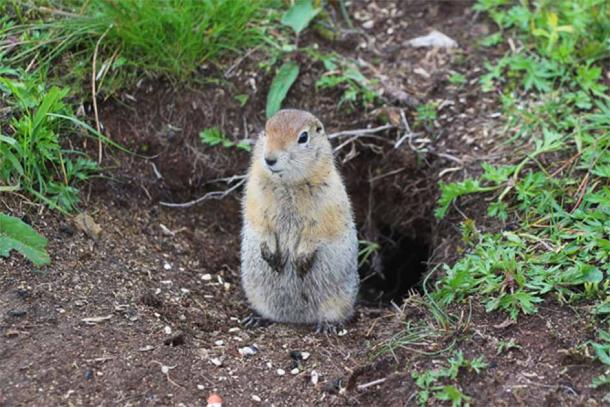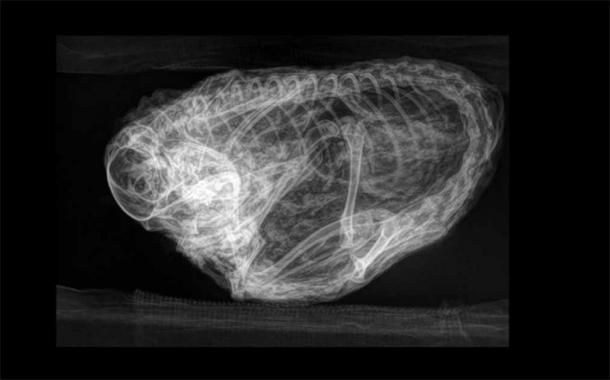
Fossilized Fur Ball Turns out to be Frozen Ice Age Squirrel!
In 2018, miners working in northern Canada discovered a small, tannish-brown, grapefruit-sized lump. This mass of claws and limbs appeared to be made of fossilized fur upon examination with the naked eye, and was not immediately seen as a significant find. After five years of studying the mysterious blob, paleontologists now believe that it is all that remains of an Ice Age squirrel - a perfectly preserved Arctic ground squirrel that lived approximately 30,000 years ago.

The finding of a frozen Ice Age squirrel will provide researchers the opportunity to study its physical characteristics and genetic makeup and compare them to their modern-day counterparts, such as the Arctic Ground Squirrel. (Андрей Рыков / Adobe Stock)
Hester, the Fossilized Ice Age Squirrel, Brings Ancient History to Life
The mummified creature, which was curled up into a tight ball, likely died while hibernating, and has been named Hester, after Hester Creek in the Klondike Gold Fields near Yukon in Canada where it was found. “It's amazing to think that this little guy was running around the Yukon several thousand years ago,” they shared on the Yukon Beringia Interpretive Centre Facebook page.
- 8 of the Most Popular Animal Species in the Ancient World
- Squirrels, Armadillos and Now Apes Have Leprosy
The fossilized squirrel is an unusual and exciting specimen which will soon go on display at the interpretive center in Whitehorse, Canada. Although the museum is currently closed, it is slated to reopen to the public this spring with a range of new exhibits, including the mummified Ice Age squirrel, along with a preserved black-footed ferret found in the same region, reported CBC News.
“It's not quite recognizable until you see these little hands and these claws, and you see a little tail, and then you see ears,” said Grant Zazula, a Yukon government paleontologist. “When you see an animal that's perfectly preserved, that's 30,000 years old, and you can see its face and its skin and its hair and all that, it's just so visceral.”

X-ray of the fur ball, that is now known to be an Ice Age squirrel from 30,000 years ago. (Yukon Beringia Interpretive Centre)
Discovering and Defrosting the Ice Age Squirrel
The miners discovered the Ice Age squirrel's remains in a goldfield near Dawson City, located in the Klondike region of the Yukon territory, not far from the Alaskan border. This area has produced several well-preserved animal specimens from the Ice Age, including giant beavers, a baby mammoth, and even a wolf pup.
“Animals that we have here today are actually pretty tough, because they've had to endure these numerous changes in the past,” explained Zazula. “So that's a really important lesson in terms of trying to think about how future climate change will impact these animals," Zazula said.
The furry, fossilized lump that the miners discovered did not initially resemble much of anything. Upon closer inspection, researchers were able to spot the squirrel’s little feet and claws, as well as its ears and tail. After spending several millennia in the permafrost, the squirrel’s remains were too fragile to unfurl.
Researchers enlisted the help of a veterinary practice with an X-ray machine. Before scanning the animal, they worried the images wouldn’t be clear; perhaps the bones’ calcium had deteriorated over such a long period of time. However, their X-rays revealed a remarkably intact skeleton. Paleontologists suspect the squirrel was young, but are unsure of how it died.

A paleontologist x-raying the prehistoric ground squirrel remains. (Yukon Beringia Interpretive Centre)
Paleontology Uncovering Arctic Ground Squirrel Facts
Arctic ground squirrels survived after the Ice Age and still inhabit Yukon and Alaska today. These little mammals are especially intriguing to scientists who wonder if they may be able to withstand future changes to the climate. The discovery of this perfectly preserved specimen offers researchers a unique opportunity to study the physical characteristics and genetic makeup of an Ice Age squirrel and compare them to their modern-day counterparts.
Arctic ground squirrels look more like modern-day gophers than most squirrels, thanks to their flat ears, thin tails and tendency to stand on their back two feet. These rodents typically measure about 15 inches (38.1 cm) long and weigh roughly 1.5 pounds (0.68 kg). Although they often live to be nine years old, they can end up as prey for carnivorous predators like grizzly bears, ermines and raptors, according to the Yukon government.
- Mysterious Cases of Living Fossils, Suspended Animation, and Hibernation
- Miners Strike Ice Age Gold Finding a Mummified Wolf Cub
During the warmer months, the squirrels forage for a wide variety of foods, ranging from mushrooms to berries. However, starting around early October, they retreat to their underground burrows and hibernate until mid-April. During that time, their body temperature dips to below freezing, reaching about 27 degrees Fahrenheit (-2.7 degrees Celsius) - the lowest measured body temperature of any mammal, reported Live Science.
“Some people get really, really excited when they find that giant woolly mammoth leg or, you know, the big tusks or the big skulls,” highlighted Zazula. “But for me, the Arctic ground squirrel fossils, the nests, and now this mummified squirrel, are really the coolest things that we do have. They're my favorites, for sure,” he concluded
Top image: The 30,000-year-old ball of preserved fur and bones that has been found to be an Ice Age squirrel. Source: Yukon Beringia Interpretive Centre
By Sahir Pandey
References
Baker, H. 6 April 2023. “30,000-year-old fur ball hidden in Canadian permafrost is actually a mummified squirrel” in Live Science. Available at: https://www.livescience.com/30000-year-old-fur-ball-hidden-canadian-permafrost-actually-mummified-squirrel
CBC News. 29 March 2023. “'Brown blob' found in Yukon is a well-preserved Ice Age squirrel” in CBC. Available at: https://www.cbc.ca/news/canada/north/yukon-mummified-arctic-ground-squirrel-1.6794991
Kuta, S. 7 April 2023. “This Mummified Ice Age Squirrel Was Found Frozen in Canada” in Smithsonian Magazine. Available at: https://www.smithsonianmag.com/smart-news/this-mummified-ice-age-squirrel-was-found-frozen-in-canada-180981955/
Panella, C. & McFall-Johnsen, M. 11 April 2023. “A gold miner found a mysterious grapefruit-sized fur ball. It turned out to be a 'perfectly preserved' 30,000-year-old squirrel” in Business Insider. Available at: https://www.businessinsider.in/science/news/a-gold-miner-found-a-mysterious-grapefruit-sized-fur-ball-it-turned-out-to-be-a-perfectly-preserved-30000-year-old-squirrel-/articleshow/99415719.cms
Theresa, D. 3 April 2023. “Back to the Ice Age: 30,000-year-old Arctic ground squirrel was perfectly preserved in frost” in Interesting Engineering. Available at: https://interestingengineering.com/science/ice-age-30000-arctic-squirrel
Tonkin, S. 11 April 2023. “Mysterious fur ball found frozen in Northern Canada turns out to be a mummified SQUIRREL that died 30,000 years ago” in The Daily Mail. Available at: https://www.dailymail.co.uk/sciencetech/article-11960225/Mysterious-fur-ball-frozen-Canada-turns-mummified-squirrel.html















